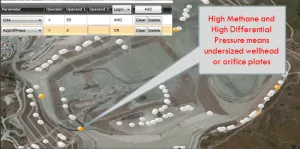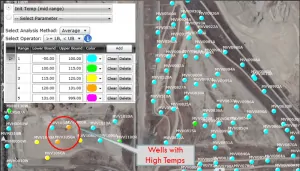

This module of SCSeTools® facilitates the capture and utilization of landfill gas (LFG) and other solid waste and industrial facility monitoring and management data. This information is used for environmental compliance reporting, document management, due diligence, and operational analyses.
SCS DataServices, already implemented at hundreds of landfills across the United States, provides a range of customized documents and charts created and stored in a library for use at a moment’s notice. Documentation is specific to business operations; LFG collection system operators, for example, use an essential combination of records and reports from their landfill’s personalized library.
SCS DataServices allows clients to get started quickly by providing near real-time data maps with time-saving options for mapping and charting. Several common LFG operational tasks include identifying:
A single component of SCS DataServices, the Range Map, can be used to manage these standard LFG operations. The screenshots below demonstrate that SCS’s color-coded Range Maps highlight specified conditions. Clients no longer need to transfer spreadsheet data using colored markers for generating maps. The charts provide perspective and understanding of data over time and are useful for many purposes. Clients can choose any parameter that the field equipment collects and set custom ranges to quickly identify trends throughout their landfill, as shown here:


In addition to Range Maps, SCS DataServices® employs Filters on the maps to set ranges for multiple parameters. One of the most useful Filters, shown below-right, locates wells with high methane and high differential pressure, saving time and money in identifying undersized wellheads or orifice plates.


SCS DataServices offers trend analysis, anomaly investigation, data mapping, and detailed reporting. Crucial site documents are stored and retrieved from a secure server with 24/7 access. Clients can grow a library of reports dedicated to improving operational and compliance efficiencies. Trending analysis findings can be produced in customizable reports specific to regulatory requirements. Dedicated reports eliminate the need to export, analyze, and format raw data, allowing clients to compile and submit regulatory-grade reports with the click of a button.
Contact SCS to learn more about SCSeTools® or to request a demonstration.